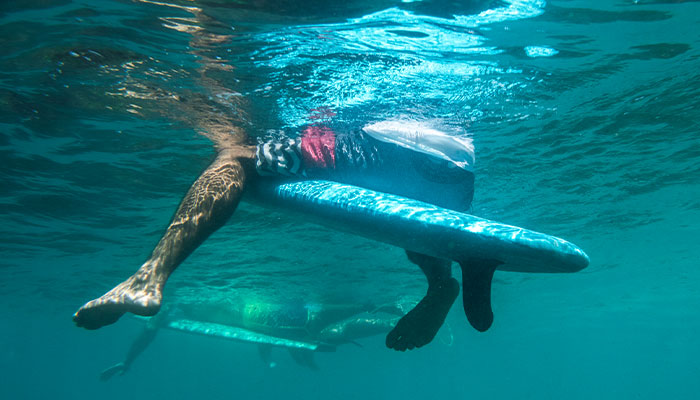News release
From:
White sharks are often portrayed as ‘mindless killers’ and ‘fond of human flesh’, but a new study, the first to test the long-held theory that some bites on humans may instead be the result of mistaken identity, has confirmed that sharks can mistake humans for their natural prey based on visual similarities.
Scientists from Macquarie University, in collaboration with Taronga Zoo, University of Exeter, La Trobe University, Oceans Research Institute, University of Western Australia, University of Bristol, Flinders University and NSW Department of Primary Industries have created a virtual white shark visual system to understand how these top marine predators see the world. Video footage of seals, and of humans swimming and paddling surfboards, obtained at Taronga Zoo, were compared to predict what a juvenile white shark sees when looking up from below.
“Until now, the potential similarity between humans and seals has been assessed based on human vision. However, white sharks have much lower visual acuity than us, meaning they cannot see fine details, and lack colour vision,” says lead author Dr Laura Ryan. “In these experiments, we were able to view the world through the eyes of a white shark.”
The poor acuity of juvenile white sharks means that they cannot discriminate between humans swimming or paddling surfboards and seals when viewed from below. The mistaken identity theory is thought to be most relevant to juvenile white sharks because they are responsible for a large proportion of bites on humans, and this is a life stage when they begin to incorporate seals into their diet. This is the first study of its kind to assess the plausibility of the mistaken identity theory behind shark bites on humans. The findings were published in the Royal Society Interface.
“We confirm the plausibility of the mistaken identity theory from a visual perspective, but sharks can also detect prey using other sensory systems,” Dr Ryan says.
“While it seems unlikely that every bite on a human by white sharks are a result of mistaken identity, in circumstances where surface objects, like surfers, are targeted from below, it is very possible.”
Professor Nathan Hart, Macquarie University’s Head of Biological Sciences says, “White sharks also have to learn what to eat and at around 2.5 metres their jaws begin to harden so they can take on bigger prey like seals. They need to develop a search image for these prey items and combine that with other sensory information;
it’s a learning process that could be prone to mistakes.”
Shark bites are rare but are increasing in frequency as more people use the water year-round for sport and recreation. The uncertainty around why bites occur generates substantial public concern and typically leads to measures to reduce shark abundance, which often also harms other marine life, says Dr Ryan.
“Greater understanding will hopefully lead to improved solutions that not only prevent shark bites but also don’t needlessly endanger other marine wildlife,” she says.
“In fact, the findings of this study have inspired the design of non-invasive vision-based shark mitigation devices, which are currently being tested.”
The paper – published in the journal Royal Society Interface – is the latest research to change perceptions about the behaviour of apex fish.
Ryan, L, Slip, D, Chapuis, L, Collin, S, Gennari, E, Hemmi, J, How, M, Huveneers, C, Peddemors, V, Tosetto, L & Hart, N (2021) A shark's eye view: testing the 'mistaken identity theory' behind shark bites on humans. Royal Society Interface.



 Australia; NSW
Australia; NSW


